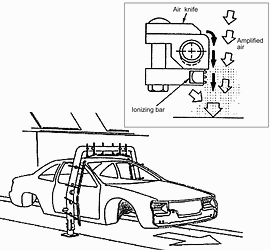
As the automotive industry continues its change from metal to engineered plastics for many components, one persistent problem is static electricity on the plastic surfaces. Static results in poor-quality finishes and dust entrapment in plastic assemblies. Poor finish is particularly abhorrent to this appearance-conscious industry.
Very simply, static electricity occurs whenever two materials are mechanically worked together, or when two materials in contact are separated rapidly. Through a process called tribo-electrification, electrical equilibrium is disrupted. One material loses electrons to become positively charged while the other gains them to become negatively charged. The material's conductivity determines its ability to pass along this charge. Good conductors, such as metals, can lose a static charge almost immediately. Insulators, such as plastics, retain their static charge - sometimes for weeks.
Many normal handling operations generate static. These include parts moving on conveyor belts, sliding down chutes, or simply rubbing against each other. In fact, manual cleaning with tack rags or using a compressed air blow-off to remove visible dirt will impart an invisible static charge to attract and hold more dirt as the part travels through the production pipeline.
Three basic approaches can eliminate static charges:
* Climate control - particularly temperature and relative humidity - in the work area.
* Applying conductive media to the charged surface.
* Ionising the air around the working surface.
Climate control often proves logistically difficult and expensive. Conductive coatings may be detrimental to the product and other processes. Ionising the air does not alter the material or its surface, and therefore has become the option of choice for neutralising static on plastic surfaces. (For many years, ionising has performed in the printing and converting industries where extremely high static charges are encountered as paper and cardboard are processed through presses and forming machines.)
One system to fight static is the Typhoon+ that combines electrical ionisers with air knife amplifiers to clean and neutralise plastic and other surfaces prior to painting or other finishing operations. Typically, the ioniser consists of a bar with rows of very sharp pins. The bar's configuration and length varies with the application. When electrically charged from 5 to 10 000 V, the pins create a high-potential gradient at their tips which overstresses and ionises the air in the region.

The air knife amplifier - from Ex-air Corp, Cincinnati - uses a small volume of filtered compressed air as its power source. The knife discharges this compressed air through a 0,002" gap along its length, generating high-velocity, laminar pneumatic flow that pulls in large volumes of ambient air. Amplification ratios entrained-air/compressed-air - can run as high as 30:1.
The high-volume air stream passes over the electrical ioniser mounted at the bottom of the knife, capturing much of the ion cloud, and delivering to the work surface, which can be up to 15 ft away. The ions neutralise static charge and the air also scrubs and cleans the surface. Because of the amplification factor, the air knife consumes much less energy than blow guns or other types of airborne systems.
When combined with sensors and valving in a production situation. Typhoon+s provide a simple, inexpensive, and safe answer to static electricity problems.
For more information contact E-Test, 031 702 8302.

© Technews Publishing (Pty) Ltd | All Rights Reserved